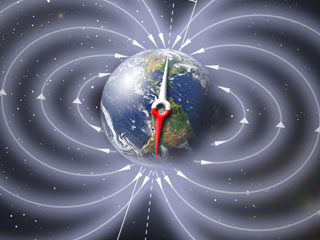12.28.2009
Evidence of macroscopic quantum tunneling detected in nanowires
http://news.illinois.edu/news/09/0527tunneling.html


A team of researchers at the University of Illinois has demonstrated that, counter to classical Newtonian mechanics, an entire collection of superconducting electrons in an ultrathin superconducting wire is able to “tunnel” as a pack from a state with a higher electrical current to one with a notably lower current, providing more evidence of the phenomenon of macroscopic quantum tunneling.
Physics professors Alexey Bezryadin and Paul Goldbart led the team, with graduate student Mitrabhanu Sahu performing the bulk of the measurements. Their research was published on the Web site of the journal Nature Physics on May 17.
Quantum tunneling is the capability of a particle to inhabit regions of space that would normally be off-limits according to classical mechanics. This research observes a process called a quantum phase slip, whereby packs of roughly 100,000 electrons tunnel together from higher electrical current states to lower ones. The energy locked in the motion of the electrons as they phase slip is dissipated as heat, causing the nanowires to switch from a superconducting state to a more highly resistive one.
It’s through this switching of states that allows the tunneling of the phase slip to be observed, the researchers say.
Goldbart, who is also a researcher at the university’s Frederick Seitz Materials Research Laboratory, describes a quantum phase slip as a phenomenon that allows the spatially extended structure of superconductivity “to undergo a kind of quantum mechanical rip or tear, one where the entire extended behavior of the superconductivity tunnels its way through a classically forbidden set of configurations.”
“Semiconductors, insulators and metals all hinge upon the ability of particles to make it through classically forbidden regions, despite apparently having negative kinetic energy there, as quantum physics allows,” Goldbart said.
In Newton’s world, according to Goldbart, particles would be reflected from such regions.
Although quantum mechanics governs the realm of atoms and molecules and smaller, quantum phenomena sometimes “leak up” to macroscopic scales, he said.
Read more...
Physics professors Alexey Bezryadin and Paul Goldbart led the team, with graduate student Mitrabhanu Sahu performing the bulk of the measurements. Their research was published on the Web site of the journal Nature Physics on May 17.
Quantum tunneling is the capability of a particle to inhabit regions of space that would normally be off-limits according to classical mechanics. This research observes a process called a quantum phase slip, whereby packs of roughly 100,000 electrons tunnel together from higher electrical current states to lower ones. The energy locked in the motion of the electrons as they phase slip is dissipated as heat, causing the nanowires to switch from a superconducting state to a more highly resistive one.
It’s through this switching of states that allows the tunneling of the phase slip to be observed, the researchers say.
Goldbart, who is also a researcher at the university’s Frederick Seitz Materials Research Laboratory, describes a quantum phase slip as a phenomenon that allows the spatially extended structure of superconductivity “to undergo a kind of quantum mechanical rip or tear, one where the entire extended behavior of the superconductivity tunnels its way through a classically forbidden set of configurations.”
“Semiconductors, insulators and metals all hinge upon the ability of particles to make it through classically forbidden regions, despite apparently having negative kinetic energy there, as quantum physics allows,” Goldbart said.
In Newton’s world, according to Goldbart, particles would be reflected from such regions.
Although quantum mechanics governs the realm of atoms and molecules and smaller, quantum phenomena sometimes “leak up” to macroscopic scales, he said.
“Observing switching events in superconducting nanowires at high-bias currents provides strong evidence for quantum phase slips. Our experiments provide further evidence that the laws of quantum mechanics continue to govern large systems, composed of many thousands of electrons, acting as a single entity.”
Tags:
Nature,
Physics,
quantum mechanics,
science,
technology
Earth's north magnetic pole racing towards Russia due to core flux
http://www.newkerala.com/news/fullnews-18585.html
A new research has determined that Earth's north magnetic pole is racing toward Russia, at almost 40 miles (64 kilometers) a year, due to magnetic changes in the planet's core.
The core is too deep for scientists to directly detect its magnetic field. But researchers can infer the field's movements by tracking how Earth's magnetic field has been changing at the surface and in space.
[...]
The magnetic north pole had moved little from the time scientists first located it in 1831.
Then in 1904, the pole began shifting northeastward at a steady pace of about 9 miles (15 kilometers) a year.
In 1989 it sped up again, and in 2007 scientists confirmed that the pole is now galloping toward Siberia at 34 to 37 miles (55 to 60 kilometers) a year.
Read more...
The core is too deep for scientists to directly detect its magnetic field. But researchers can infer the field's movements by tracking how Earth's magnetic field has been changing at the surface and in space.
[...]
The magnetic north pole had moved little from the time scientists first located it in 1831.
Then in 1904, the pole began shifting northeastward at a steady pace of about 9 miles (15 kilometers) a year.
In 1989 it sped up again, and in 2007 scientists confirmed that the pole is now galloping toward Siberia at 34 to 37 miles (55 to 60 kilometers) a year.
Monoatomic Elements
http://www.halexandria.org/dward479.htm

[Also...]
David Radius Hudson
ORME: Orbitally Rearranged Monoatomic Elements
Rhodium and Iridium
White Powder of Gold

Monoatomic elements are nothing more than elements which are chemically isolated, i.e. instead of 60 atoms of Carbon are 34 atoms of Silicon being bound together in something called a Buckministerfullerene or a knobbier version of the same. The significance lies in the fact that when a single element metal progresses from a normal metallic state to a monoatomic state, it passes through a series of chemically different states. These include:
Other elements which have many of these same properties are the Precious Metals, which include Ruthenium, Rhodium, Palladium, Silver, Osmium, Iridium, Platinum, and Gold. All of these elements have to greater or lesser degree, the same progression as gold does in continuously reducing the number of atoms chemically connected. Many of these precious elements are found in the same ore deposits, and in their monoatomic form are often referred to as the White Powder of Gold.
Read more...- An alloy of numerous atoms of the same element, which exhibit all the characteristics normally associated with the metal: electrical conductivity, color, specific gravity, density, and so forth. The atom’s intrinsic temperature might be room temperature.
- A combination of significantly fewer atoms of the same element, which no longer exhibit all of the characteristics normally associated with the metal. For example, the electrical conductivity or color might change. The atom’s intrinsic temperature drops, for example, to 50 to 100 °K (or about two hundred degrees below zero °C).
- A Monoatomic form of the element -- in which each single atom is chemically inert and no longer possesses normal metallic characteristics; and in fact, may exhibit extraordinary properties. The atom’s intrinsic temperature is now about 1 °K, or close enough to Absolute Zero that Superconductivity is a virtually automatic condition.
Other elements which have many of these same properties are the Precious Metals, which include Ruthenium, Rhodium, Palladium, Silver, Osmium, Iridium, Platinum, and Gold. All of these elements have to greater or lesser degree, the same progression as gold does in continuously reducing the number of atoms chemically connected. Many of these precious elements are found in the same ore deposits, and in their monoatomic form are often referred to as the White Powder of Gold.
[Also...]
David Radius Hudson
ORME: Orbitally Rearranged Monoatomic Elements
Rhodium and Iridium
White Powder of Gold
[...and, interestingly, a quarterly journal supporting research on the science and technology of the platinum group metals and developments in their application in industry -in its 53rd year of publication:]
Platinum Metals Review
Tags:
awareness,
Consciousness,
health,
Precious metal,
science,
video,
youtube
Jesse Ventura - Conspiracy Theory (Ep. 2, 3 & 4)
Episode 2: 9/11
Episode 3: Global Warming
Episode 4: Big Brother
Episode 3: Global Warming
Episode 4: Big Brother
Tags:
9/11,
big brother,
conspiracy,
cover-up,
Environment,
nwo,
police state,
truth,
video,
youtube
Subscribe to:
Comments (Atom)








.png)




